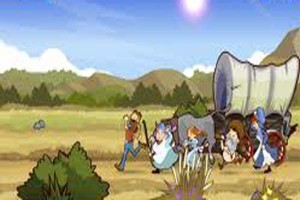Oregon Trail is the name of a series of video games originally produced by the Minnesota Educational Computing Consortium (MECC) in 1981. Players control a fictional family traveling in a covered wagon from Missouri to Oregon in 1848. The game was intended to teach students about pioneer life, and became one of the most popular educational video games ever, boasting twelve sequels and new editions since its debut.
The Oregon Trail was first created in 1971, when student teacher Don Rawitsch designed the game for use in an 8th grade history class. It caught the students’ attention immediately, and though Rawitsch deleted the program, he kept the source code. This proved fortunate, as the MECC hired Rawitsch in 1974 to refine his game for use in schools across Minnesota. The first edition of The Oregon Trail was an instant success, and in 1981 MECC published the game publicly.
Players begin the game by choosing a profession, which determines how much money they have and their relative skills: bankers have plenty of money to buy resources, but few useful skills, while poorer farmers or carpenters are able to hunt or repair their wagons more reliably. While on the journey with their family, players must decide how to cross bodies of water, care for sick children, hunt for food, and protect themselves from other hazards of pioneer life. Family members commonly died of dysentery, which gave rise to a minor Internet meme in the mid-2000s.
Today, the Oregon Trail series is available worldwide in a multitude of editions for major platforms, including Nintendo systems, cell phones, tablets, and computers. It has also inspired a number of spin-offs from MECC and other publishers, including Amazon Trail and the controversial Freedom!, which put players in control of an escaped slave. It is sold by the Learning Company.
Videos
Featured Image Via: blog.games.com
